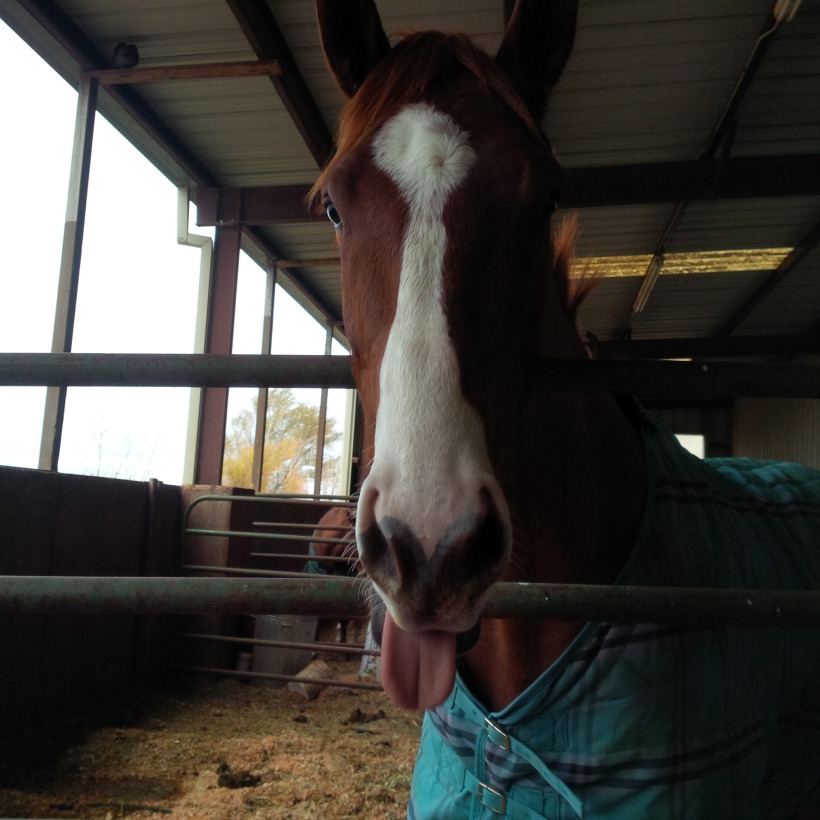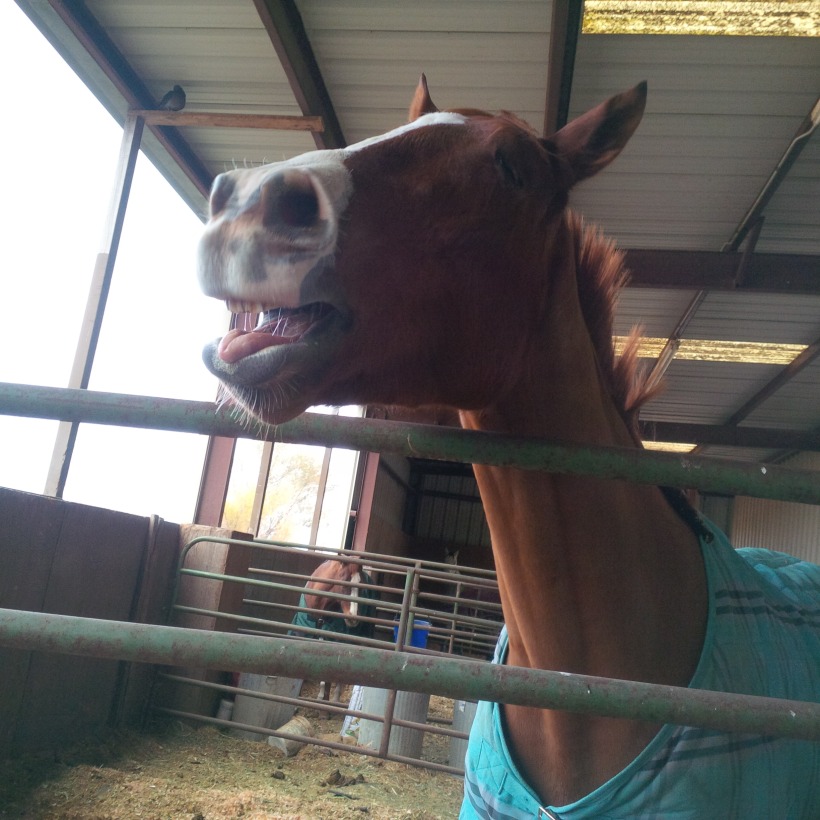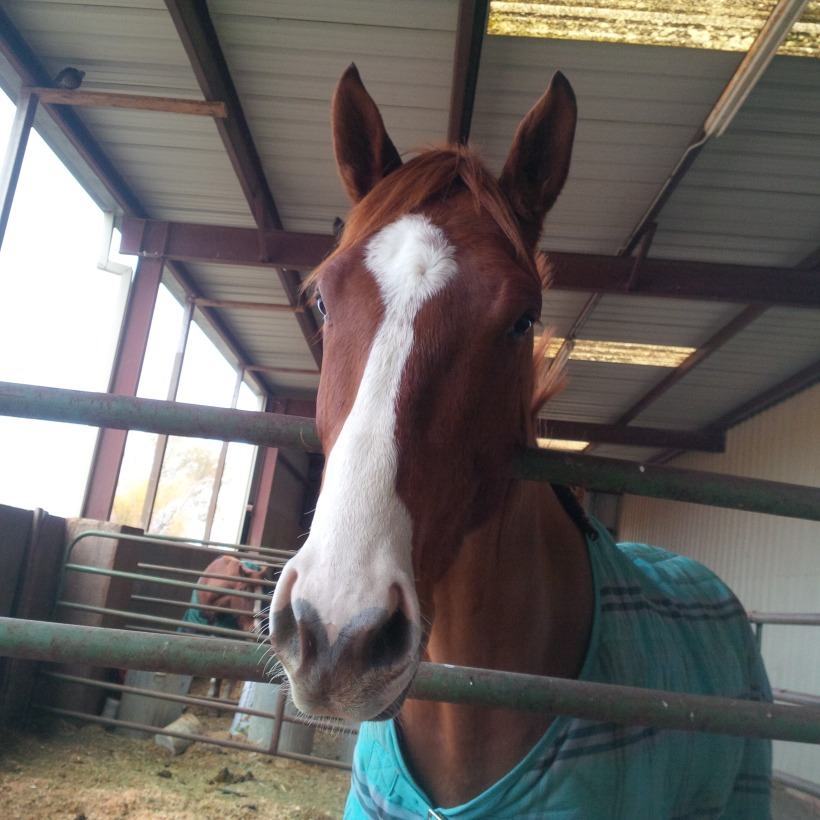Thanksgiving week came and went, so I hadn’t ridden C in five days, and I’d just scheduled a jump lesson.
What sort of madwoman thought that was a good idea?
Thankfully, T did three training rides this week, so it wasn’t as though he’d be crazy, right? It wasn’t like he’d go nuts, because he’d been worked a few times. Besides, he’s a pretty quiet guy! He’d never, ever–
Hello, chilly day, and hello, acrobatics, the likes of which I have never seen (or felt) out of C before. Perhaps not to the same degree as Nicole’s horse Murray (or even, really, on the same spectrum), but in a definitively un-C-like manner.
At the trot, he’d flip his head and break to a canter, over and over. On the bright side, he’d get the correct lead. On the less bright side, he was cantering through my posting, and kept tossing his head and pinning his ears. Once I finally got him to a trot and made him wait for me to ask, and then asked, he ninja-kicked to the outside. To his credit, he still got the correct lead, thereby prompting a simultaneously jubilant and irritated sort-of-strangled pterodactyl cry from me.
Jumping was wonderful. He was responsive to my half-halts and seat, took the fences without stopping or peeking, and we only demolished one jump on the whole course! Besides that, we were in matching pink. Evidence below.
I sort of assumed he was just a little sore from the training rides. I’ll excuse the behavior, I thought, because he must be sore behind. I got off after walking him out, untacked him, and checked his back. No response. And his butt? Not so much as a twitch. So why, dear little C, were you complaining so much today?
I think the answer is equine linguistics.
What was C trying to communicate when he pinned his ears and started bobbing in a weird up-and-down half-canter trottamajig? It wasn’t back pain– the saddle fits and he wasn’t sore. The more I thought about it, the more I wondered if it was a product of my own doing. Lately to fix the canter leads, we canter and if he’s got the wrong lead, we trot and then canter again straight away (rinse and repeat if we miss it again). Was he simply making the connection that trot served only as a transition from walk to canter? If that’s the case, making him trot on my terms was the solution. So why was he kicking out when I finally said, “Okay, let’s canter.”?
I think, honestly, it was a combination of the weather and a baby horse tantrum.
Still, this situation made me think back to other situations where C had misinterpreted my cues. I feel as though the saying “When you get on a green horse, you are either training or untraining them” really applies here. A while ago I was wondering why C was interpreting my left leg as pressure to give to (as he’s meant to) and why he was interpreting the right leg as a ‘go’ button. And I realized that I did something that taught him that, because he sure as hell didn’t learn it on his own. I imagine that, being right-leg dominant, when I asked for transitions I simply squeezed a little tighter with my right leg, thus telling him (unintentionally) that right leg means upward transition, or ‘go’.

This translates to: I want my grain

and this translates to: I REALLY want my grain
I wonder how many other gaps I have unintentionally caused. For his leads, have I reinforced cantering on the wrong lead by leaning a certain way, or taking too long to remedy it? Did I teach him to jump strung-out and flat by asking for a long spot in our last lesson? Have I unwittingly installed bad, or just unusual, habits into my green horse?
I feel the longer I ponder this, the more I’ll fret. So for now, I’ll try to identify what I can fix about myself and my position to more clearly tell C what I want from him, and be patient when he doesn’t respond the way I want.
I need to remember that while I’m trying to learn his language (loosely: ears, body, and reactions), he’s also trying to learn mine (seat, leg, hands, and reactions). As far as equine linguistics go, I’ll try to interpret them as they come.

And this translates to: cutest jerk ever.
— M





December 1, 2015 at 7:46 pm
“Strangled pterodactyl cry”!!! That is the most brilliant description I have ever heard. I’ve heard that cry so many times from riders that lose it with their horses and now have a name for it! I wish I could have seen it happen. (Still laughing)
I think you’re right about the linguistics. I remember one rider telling me after SHE cleared a 1.40 meter jump, while her horse stood still admiring the paint job on the top rail. “It was totally my fault. I forgot to tell him to jump. I was too busy counting off the strides. I’m going ‘was it three or four’ and he’s saying ‘ok you’re not tell me I should jump, so i’ll stop.”
Great post and photos. 🙂
LikeLike
December 1, 2015 at 9:06 pm
Glad to put a name to the sound! Spelled out, I think it’s something like “HEEEuurghhaawaaghhH”. Ouch for that rider!! And thank you! 🙂
LikeLike
December 1, 2015 at 9:19 pm
LOL! Can I use it? I think I’ll post a photo that goes with it. 🙂
LikeLike
December 1, 2015 at 9:35 pm
Sure thing! A link back would be awesome but you don’t need to if it doesn’t work. 🙂
LikeLike
December 1, 2015 at 9:54 pm
Oh absolutely! Your post is the reason for it. I’m working on it. You’ll see shortly. 😉
LikeLike
December 1, 2015 at 9:56 pm
Looking forward to seeing it!!
LikeLike
December 1, 2015 at 10:24 pm
It’s posted! 🙂 Thanks again for the inspiration. 🙂
LikeLiked by 1 person
December 1, 2015 at 8:31 pm
Training a baby horse will make you question everything you do at all times!
The best plan? Keep it simple and stay confident!! Your trainer won’t steer you wrong (I know, I’ve been there!) I remember one memorable lesson when trainer was like “so you’re having trouble with canter transitions, tell me how you’re asking.” and I was like “well, first I bend him to the inside and push him to the outside a little and then I put my outside leg back and I try not to hold too much with my hands…” and she was like “um, let’s try asking with LESS….” Magic!
But really, do not doubt yourself too much. Just work on the things you know you can do, and try to stay accountable with your body (super hard, I know!), and you’ll get it right. 🙂
LikeLike
December 1, 2015 at 9:08 pm
Ooh, I like that description of it– asking with less, using simpler terms, is definitely more likely for the pony to understand. Confidence is in the works. 😉 Thanks Nicole!
LikeLike
Pingback: Equine Linguistics or “HEEEuurghhaawaaghhH” | Back Home in Bromont
December 1, 2015 at 11:04 pm
Just found your blog and looking forward to catching up. I also have a greenie and will soon be going through the same trials and tribulations 😊
LikeLiked by 1 person
December 2, 2015 at 6:33 pm
Awesome! Welcome to the blog. 🙂 Looking forward to seeing (and probably relating to) your posts, too!
LikeLike
December 7, 2015 at 4:52 pm
It’s amazing how quickly they learn things we don’t know we’re teaching (and then how much that interferes with what we think we’re teaching, but aren’t). Pink on point!
LikeLike
Pingback: 2016 Resolutions and Goals | Canter & Candor